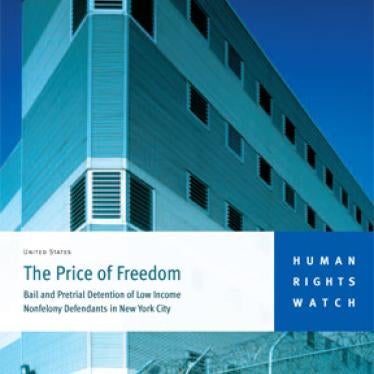In 1970, the New York Legislature reformed the state's bail law with the goal, among other things, of reducing the number of people behind bars solely because they could not afford to pay for their pretrial freedom. The reforms included an expansion of the forms in which bail could be set, giving judges a range of options, such as unsecured appearance or surety bonds, that would be easier for low income defendants.
Unfortunately, our research into New York City bail for nonfelony defendants indicates that judges invariably set bail in the most financially onerous forms-cash or secured bonds. They also set bail at a level the defendants cannot afford.
In 70 percent of nonfelony bail cases, judges set bail between $500 and $1,000, with bail at $1,000 accounting for 30 percent of the cases. This may not seem like a lot of money. But for people scrambling to pay the rent each month or who live on the streets, a $1,000 bail is as impossible to make as one of $100,000.
Almost nine out of 10 nonfelony defendants who have bail set at or lower than $1,000 will be unable to post it at arraignment. Too poor to buy their pretrial freedom, they will spend an average of two weeks behind bars, accused of low level offenses such as smoking marijuana in public, shoplifting, jumping turnstiles, possessing small amounts of drugs or getting into a fight.
Sending nonfelony defendants to jail for want of a few hundred dollars cannot be squared with basic notions of fairness, the right to liberty and the right to equality under the law. It is also expensive. Men and women accused of misdemeanors who cannot post bail account for almost one in four of the annual admissions to New York City jails. Using data provided by the New York City Department of Correction, we calculate New York City could save at least $42 million annually if those defendants were not subjected to pretrial detention.
In the eyes of the law, pretrial detention is not punishment but a precautionary measure to ensure defendants show up in court. From the perspective of those enduring days and nights behind bars, this is a distinction without a difference.
Pretrial detention for misdemeanor defendants is particularly troubling given that one in five of those detained will ultimately not be convicted, typically because their case is dismissed or adjourned in contemplation of dismissal.
It is also disproportionate to the punishment that can be expected for those who are convicted. Only one in five convicted misdemeanants receive jail sentences, and half of those sentences are for less than 15 days; indeed, in 9 percent of the cases, the jail sentence is less than five days. Some misdemeanants thus receive sentences shorter than the length of time in pretrial detention. Pretrial detention as well as time in police lockup pre-arraignment is punishment paid in advance for the 19.5 percent who receive sentences of time served.
As research by the New York City Criminal Justice Agency has shown, pretrial detention of nonfelony defendants also increases the likelihood of a conviction. This may reflect the frequency with which nonfelony defendants plead guilty to avoid or end time pretrial behind bars. A defendant who pleads guilty mostly likely goes home with a sentence of conditional discharge, a fine or time served. If a defendant does not accept the plea, she can spend weeks or months behind bars before the case ends. Not surprisingly, about 60 percent of misdemeanor arrests result in guilty pleas.
New York law gives nonfelony defendants a statutory right to release on recognizance or bail. The law also gives judges broad discretion to make release and bail decisions. There is nothing in the legislative history, however, to suggest the Legislature meant bail to operate as a sub rosa vehicle for sending nonfelony defendants to jail pretrial.
Everyone who has spent any time in New York City's criminal courts knows most defendants are poor if not destitute. Why then do judges set bail at less than $500 in only 2 percent of New York City's nonfelony cases? More than 300,000 nonfelony defendants are arraigned annually in New York City and the entire arraignment typically lasts no more than a few minutes. Judges may lack the time and information to tailor bail to the defendant's resources.
Our research also indicates, however, that some judges deliberately set bail at levels they know defendants cannot afford because they believe detention is necessary to ensure the defendants appear in court. (They may not realize 84 percent of New York City nonfelony defendants who are released pretrial show up for the court proceedings; only 6 percent miss a court appearance and do not return voluntarily within 30 days.) Some set high bail because they want the defendant behind bars for public safety reasons (e.g., in misdemeanor domestic violence cases), even though public safety is not a legislatively authorized purpose for bail. Some judges want to encourage defendants to take a plea, or to impose preemptive punishment on defendants they assume, based on prior records, to be guilty. Judges are also greatly influenced by prosecutor bail recommendations: the higher the bail requested by a prosecutor, the higher the bail that is set.
In addition to setting bail at an amount defendants cannot afford, New York City judges also persist in setting bail in the form of cash or secured bonds. Bail in the form of unsecured or even partially secured appearance or surety bonds is far less likely to pose a financial obstacle for poor defendants. Say the judge wants to set bail at $500. If bail is set in cash, the defendant must come up with the full amount or go to jail. But if the judge sets the $500 as a partially secured appearance bond and required only a 10 percent deposit of the amount (the maximum permitted by statute), the defendant would have to come up with $50 in order to secure her pretrial release. The financial incentive to return to court remains strong, because she would be liable for the remainder of the $500 if she did not make her scheduled court appearances.
It is difficult to understand why judges ignore the alternative bail forms. Longstanding court custom may be partially responsible. Cash bail and secured bonds are common practice and in the rush of arraignments, judges have little incentive to do something different. Our research also suggests many judges are simply unaware of the alternative forms of bail.
Defense counsel share some of the responsibility. Even if they know the options are available (and we found that many do not), they rarely request that bail be set in a different form because they believe therequest would be futile. If the defense bar consistently pressed for alternatives to cash bail or secured bonds, however, judicial practice might change.
The American Bar Association has long criticized financial bail, pointing out that it undermines the integrity of the criminal justice system, is unfair to poor defendants and is ineffective in achieving key objectives of the release/detention decision. The ABA's standards for pretrial release provide that financial conditions should be used only when no other conditions will provide reasonable assurance defendants will appear for future court appearances; if financial conditions are imposed, they should be set at the lowest level necessary to ensure the defendant's appearance and with regard to his financial ability; and they should not be set at an amount that results in a defendant's incarceration solely because he could not post the designated amount.
Federal bail law has similar provisions prohibiting the imposition of money bail that defendants cannot afford and which results in pretrial detention. Under the Federal Bail Reform Act of 1984, the arraigning court is required to release the defendant on his own recognizance or upon execution of an unsecured appearance bond, unless more restrictive conditions are deemed necessary. Bail may not be set in an amount that would produce pretrial detention.
A number of steps should be taken to reduce the pretrial incarceration of poor nonfelony defendants in New York City. At the very least, judges should lower bail amounts and make greater use of alternative bail options, defense counsel should urge them to do so and prosecutors should not object. New York City should also consider establishing pretrial supervision programs for nonfelony defendants who are ineligible for release on recognizance, cannot afford cash bail and who need stronger conditions to ensure return to court.
If, as we suspect is the case, pretrial detention of nonfelony defendants who cannot afford bail occurs throughout the state, legislative solutions should also be sought. For example, New York criminal procedure law could be amended to incorporate provisions similar to those proposed by the ABA or contained in federal law. At the very least, the Legislature should amend the law so that when a judge decides a nonfelony defendant should not be released on recognizance because of a flight risk, the judge must consider releasing the defendant on an unsecured or partially secured bond before setting other forms of bail.
We have focused on nonfelony defendants because pretrial detention for persons accused of minor offenses seems particularly unjust. But most of the arguments against conditioning pretrial freedom on the size of one's wallet apply equally well to felony defendants.
Although it happens every day, and is so routine as to be almost invisible, confining people in jail simply because they are too poor to pay for their freedom is a serious inequity in a criminal justice system that aspires to be just. It is time for the legal community to press for much needed reform.
Jamie Fellner is senior counsel of the US Program at Human Rights Watch and is author of the group's report "The Price of Freedom: Bail and Pretrial Detention of Low Income Nonfelony Defendants in New York City," available at Human Rights Watch web site at hrw.org.







